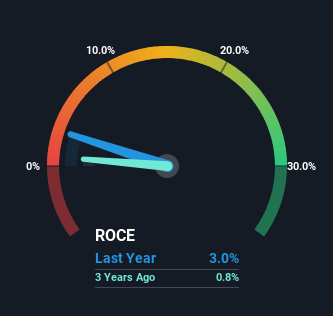PLS Plantations Berhad (KLSE:PLS) Could Be Struggling To Allocate Capital
To find a multi-bagger stock, what are the underlying trends we should look for in a business? Ideally, a business will show two trends; firstly a growing return on capital employed (ROCE) and secondly, an increasing amount of capital employed. Put simply, these types of businesses are compounding machines, meaning they are continually reinvesting their earnings at ever-higher rates of return. However, after investigating PLS Plantations Berhad (KLSE:PLS), we don't think it's current trends fit the mold of a multi-bagger.
Return On Capital Employed (ROCE): What Is It?
If you haven't worked with ROCE before, it measures the 'return' (pre-tax profit) a company generates from capital employed in its business. Analysts use this formula to calculate it for PLS Plantations Berhad:
Return on Capital Employed = Earnings Before Interest and Tax (EBIT) ÷ (Total Assets - Current Liabilities)
0.03 = RM15m ÷ (RM563m - RM66m) (Based on the trailing twelve months to March 2023).
Thus, PLS Plantations Berhad has an ROCE of 3.0%. In absolute terms, that's a low return and it also under-performs the Food industry average of 8.5%.
View our latest analysis for PLS Plantations Berhad

While the past is not representative of the future, it can be helpful to know how a company has performed historically, which is why we have this chart above. If you're interested in investigating PLS Plantations Berhad's past further, check out this free graph of past earnings, revenue and cash flow.
So How Is PLS Plantations Berhad's ROCE Trending?
On the surface, the trend of ROCE at PLS Plantations Berhad doesn't inspire confidence. Around five years ago the returns on capital were 4.7%, but since then they've fallen to 3.0%. Given the business is employing more capital while revenue has slipped, this is a bit concerning. This could mean that the business is losing its competitive advantage or market share, because while more money is being put into ventures, it's actually producing a lower return - "less bang for their buck" per se.
The Bottom Line On PLS Plantations Berhad's ROCE
From the above analysis, we find it rather worrisome that returns on capital and sales for PLS Plantations Berhad have fallen, meanwhile the business is employing more capital than it was five years ago. However the stock has delivered a 46% return to shareholders over the last five years, so investors might be expecting the trends to turn around. In any case, the current underlying trends don't bode well for long term performance so unless they reverse, we'd start looking elsewhere.
Like most companies, PLS Plantations Berhad does come with some risks, and we've found 2 warning signs that you should be aware of.
While PLS Plantations Berhad isn't earning the highest return, check out this free list of companies that are earning high returns on equity with solid balance sheets.
New: Manage All Your Stock Portfolios in One Place
We've created the ultimate portfolio companion for stock investors, and it's free.
• Connect an unlimited number of Portfolios and see your total in one currency
• Be alerted to new Warning Signs or Risks via email or mobile
• Track the Fair Value of your stocks
Have feedback on this article? Concerned about the content? Get in touch with us directly. Alternatively, email editorial-team (at) simplywallst.com.
This article by Simply Wall St is general in nature. We provide commentary based on historical data and analyst forecasts only using an unbiased methodology and our articles are not intended to be financial advice. It does not constitute a recommendation to buy or sell any stock, and does not take account of your objectives, or your financial situation. We aim to bring you long-term focused analysis driven by fundamental data. Note that our analysis may not factor in the latest price-sensitive company announcements or qualitative material. Simply Wall St has no position in any stocks mentioned.
About KLSE:PLS
PLS Plantations Berhad
An investment holding company, primarily engages in the operation and management of oil palm plantation in Malaysia, Japan, the United States, and the Republic of China.
Adequate balance sheet with acceptable track record.
Market Insights
Community Narratives




